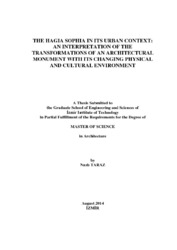Please use this identifier to cite or link to this item:
https://hdl.handle.net/11147/4300Full metadata record
| DC Field | Value | Language |
|---|---|---|
| dc.contributor.advisor | Aktüre, Zeynep | - |
| dc.contributor.author | Taraz, Nazlı | - |
| dc.date.accessioned | 2015-05-20T07:13:06Z | - |
| dc.date.available | 2015-05-20T07:13:06Z | - |
| dc.date.issued | 2014 | - |
| dc.identifier.citation | Taraz, N. (2014). The Hagia Sophia in its urban context: An interpretation of the transformations of an architectural monument with its changing physical and cultural environment. Unpublished master's thesis, İzmir Institute of Technology, İzmir, Turkey | en_US |
| dc.identifier.uri | http://hdl.handle.net/11147/4300 | - |
| dc.description | Thesis (Master)--İzmir Institute of Technology, Architecture, İzmir, 2014 | en_US |
| dc.description | Full text release delayed at author's request until 2017.09.30 | en_US |
| dc.description | Includes bibliographical references (leaves: 137-143) | en_US |
| dc.description | Text in English; Abstract: Turkish and English | en_US |
| dc.description | x, 156 leaves | en_US |
| dc.description.abstract | In this thesis, Hagia Sophia in Istanbul is handled as a living monument in its physical and cultural context in the Historic Peninsula to question the existence of a correlation between the changes in the building scale and transformations in a larger physical and cultural context. In order to do this, urban and architectural scale studies on the Historic Peninsula and Hagia Sophia are cross-read to highlight Hagia Sophia as the center of a continuously changing physical and cultural context which is changing with its transforming environment and, at the same time, changes its context through conversions that occur in the building scale up to the Ottoman conquest in the fifteenth century. This survey reveals Hagia Sophia as one of the most important architectural monuments in the world that has been a continually transforming edifice to remain in use for different civilizations in a synchronously changing urban context. The importance of the urban context of Hagia Sophia has had a major share in the maintenance of the building’s importance. Changes and continuities in Hagia Sophia, in their turn, had their share in the maintenance of the importance of the building’s urban context in a larger scale in a palimpsestic process. | en_US |
| dc.language.iso | en | en_US |
| dc.publisher | Izmir Institute of Technology | en_US |
| dc.rights | info:eu-repo/semantics/openAccess | en_US |
| dc.subject | Hagia Sophia | en_US |
| dc.subject | Historic Peninsula of İstanbul | en_US |
| dc.subject | Continuities and changes | en_US |
| dc.subject | Urban context | en_US |
| dc.subject | Palimpsest | en_US |
| dc.title | The Hagia Sophia in Its Urban Context: an Interpretation of the Transformations of an Architectural Monument With Its Changing Physical and Cultural Environment | en_US |
| dc.title.alternative | Kentsel Bağlamı İçinde Aya Sofya: Bir Mimari Anıtın Dönüşümlerinin Değişen Fiziksel ve Külterel Çevresi ile Bir Yorumu | en_US |
| dc.type | Master Thesis | en_US |
| dc.authorid | 0000-0002-2800-3508 | - |
| dc.institutionauthor | Taraz, Nazlı | - |
| dc.department | Thesis (Master)--İzmir Institute of Technology, Architecture | en_US |
| dc.relation.publicationcategory | Tez | en_US |
| dc.identifier.wosquality | N/A | - |
| dc.identifier.scopusquality | N/A | - |
| item.openairetype | Master Thesis | - |
| item.cerifentitytype | Publications | - |
| item.grantfulltext | open | - |
| item.openairecristype | http://purl.org/coar/resource_type/c_18cf | - |
| item.fulltext | With Fulltext | - |
| item.languageiso639-1 | en | - |
| crisitem.author.dept | 01. Izmir Institute of Technology | - |
| Appears in Collections: | Master Degree / Yüksek Lisans Tezleri | |
Files in This Item:
| File | Description | Size | Format | |
|---|---|---|---|---|
| T001332.pdf | MasterThesis | 14.01 MB | Adobe PDF |  View/Open |
CORE Recommender
Items in GCRIS Repository are protected by copyright, with all rights reserved, unless otherwise indicated.